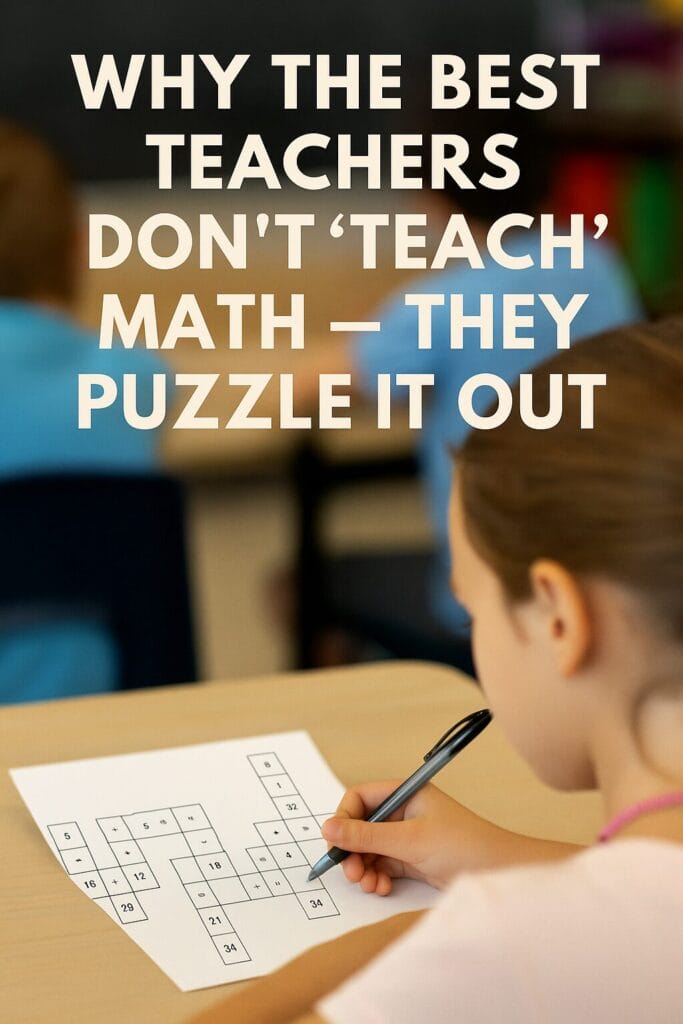Why the Best Teachers Don’t ‘Teach’ Math — They Puzzle It Out
What if teaching math wasn’t about “covering content” or “getting through the chapter”? What if it was about unlocking curiosity, challenge, and just enough friction to make it fun?
That’s what great teachers already know. And it’s why more of them are turning to puzzles, not worksheets, to engage learners across grades, abilities, and learning styles.
Let’s break down what that actually looks like in the classroom.

From Compliance to Curiosity
Most math instruction (even in good classrooms) follows this cycle:
- Explain the concept
- Model the process
- Assign practice problems
It works—until it doesn’t.
Because kids who need more time fall behind. Kids who get it early get bored. And kids in the middle start tuning out when they hit repetition fatigue.
So what if instead of forcing practice, we let learners discover it?
Why Puzzles Shift the Learning Dynamic

When you give students a puzzle instead of a page of drills, a few things happen:
- They start exploring before asking questions
- They get immediate feedback (“this doesn’t fit here”)
- They build mental stamina without realizing it
- They feel in control of the experience
And here’s the big one: They take risks.
Because puzzles don’t feel like tests. They feel like games.
Enter: Criss Cross Math Puzzles
If you haven’t seen them before, think crossword puzzle, but for equations.
- Each puzzle is a grid
- Each grid cell holds a number, operator, or equal sign
- Everything links together like a math-based logic web
Instead of solving one problem at a time, the student solves a system.
It looks like this:
👉 See Criss Cross Math in action
What Makes Them So Effective
These puzzles naturally support:
✅ Differentiation
- Adjust number range (easy to challenging)
- Vary number of equations per puzzle
- Use dynamic or fixed layouts
✅ Cross-grade utility
- Great for 2nd to 6th grade math fluency
- Also effective for review, special ed, and brain breaks
✅ Engagement
- Clean design, fast feedback, visible progress
- Feels more like a game than a test
Ways to Use Criss Cross Puzzles in the Classroom

- Morning warm-ups (1 puzzle/day = fluency over time)
- Centers and stations (different difficulty at each)
- Early finisher activities
- Homework with a twist
- Partner solve challenges
- Test review without groans
And because they’re scalable, you can:
- Build your own sets
- Batch by theme or skill level
- Print multiple versions for differentiation
Why Teachers Keep Coming Back to These Puzzles
Based on conversations with educators and homeschoolers who use logic-based math puzzles, here are a few recurring reasons they keep them in rotation:
- They make great Friday stations or small group tasks
- Kids stay focused because it feels like a game, not a worksheet
- Even reluctant learners engage without pressure
- The puzzles are structured enough to be easy to explain, but open-ended enough to adapt
- They work for multiple levels: challenge for fast finishers, support for kids who need to build confidence
Try It for Yourself (Free)
If you’re curious to test it, we’ve got a demo version you can download: 👉 Puzzle Maker Pro Demo
Or learn more about how educators are using it: 👉 Criss Cross Math Overview
No login. No credit card. Just test and see if it fits.
Related Articles
- She Said ‘I Hate Math’ — Then Solved 8 Puzzles in a Row
- Math Worksheets Are Boring. These Puzzles Aren’t.
- Not a Designer? Not a Math Teacher? Not a Problem.
The best math instruction isn’t always direct. Sometimes it’s designed to be discovered.
Let your students puzzle it out.
